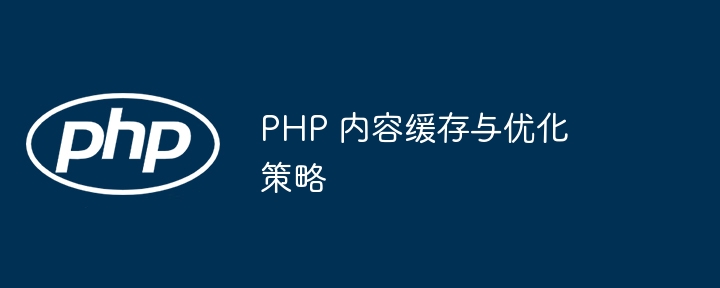Home > Article > Backend Development > PHP content caching and optimization strategies
PHP content caching and optimization strategies
- WBOYOriginal
- 2024-05-01 21:30:02547browse
Content caching can optimize PHP website response time. Recommended strategies include: Memory caching: used to cache variables, such as MySQL query results. Filesystem Cache: Used for caching content such as WordPress posts. Database cache: suitable for frequently updated content such as shopping carts or sessions. Page cache: used to cache the entire page output, suitable for static content.

PHP Content Caching and Optimization Strategy
As website traffic increases, optimizing response time is crucial. Content caching is an efficient way to do this by storing requested pages or content in advance. This article will discuss various content caching strategies in PHP and provide practical examples.
1. Memory cache
The fastest cache layer is in memory. PHP provides apc_store() and apc_fetch() functions for caching variables in the Apache process.
Practical case:
Implementing memory cache on MySQL database query:
$cacheKey = 'my_query_results';
$cachedResults = apc_fetch($cacheKey);
if ($cachedResults) {
echo 'Using cached results...';
} else {
// Execute MySQL query and store results in memory
$cachedResults = executeMySQLQuery();
apc_store($cacheKey, $cachedResults, 3600);
echo 'Query results cached for 1 hour...';
}2. File system cache
If the memory cache does not meet your needs, you may consider using the file system cache. PHP's file_put_contents() and file_get_contents() functions can be used to read and write file caches.
Practical case:
Cache WordPress post content to the file system:
$cacheFileName = 'post-' . $postId . '.cache';
$cachedContent = file_get_contents($cacheFileName);
if ($cachedContent) {
echo 'Using cached content...';
} else {
// Fetch post content from database
$cachedContent = get_the_content();
file_put_contents($cacheFileName, $cachedContent);
echo 'Content cached to file system...';
}3. Database caching
For content that changes frequently, such as shopping carts or user sessions, you may want to use database caching. This can be achieved using a key-value store like Redis.
Practical case:
Caching shopping cart data in Redis:
// Create Redis connection
$redis = new Redis();
$redis->connect('127.0.0.1', 6379);
// Get cart items from Redis
$cart = $redis->get('cart-' . $userId);
// If cart is not cached, fetch it from database
if (!$cart) {
$cart = getCartFromDatabase();
$redis->set('cart-' . $userId, $cart);
echo 'Cart data cached in Redis...';
}4. Page caching
Page caching is the most extreme form of caching, which stores the entire page output as a static file. In PHP, this can be achieved using the ob_start() and ob_get_clean() functions.
Practical case:
Cache the entire WordPress page to an HTML file:
ob_start();
// Generate page content
include('page-template.php');
$cachedContent = ob_get_clean();
// Write cached content to file
file_put_contents('page-' . $pageName . '.html', $cachedContent);
echo 'Page cached as HTML file...';Choose the correct caching strategy
Choosing the most appropriate caching strategy depends on your application needs and content type. For content that changes frequently, using an in-memory cache or a database cache may be a better choice. For static content, page caching may be ideal.
By implementing these content caching strategies, you can significantly improve your PHP website's response time.
The above is the detailed content of PHP content caching and optimization strategies. For more information, please follow other related articles on the PHP Chinese website!

